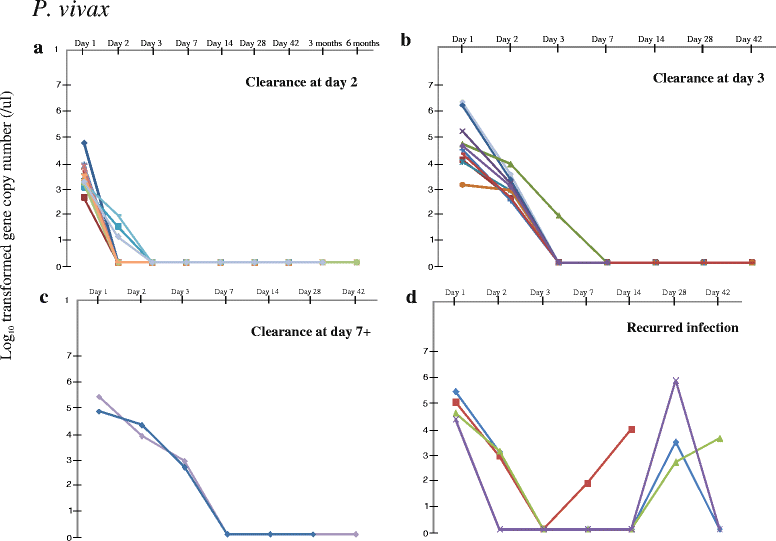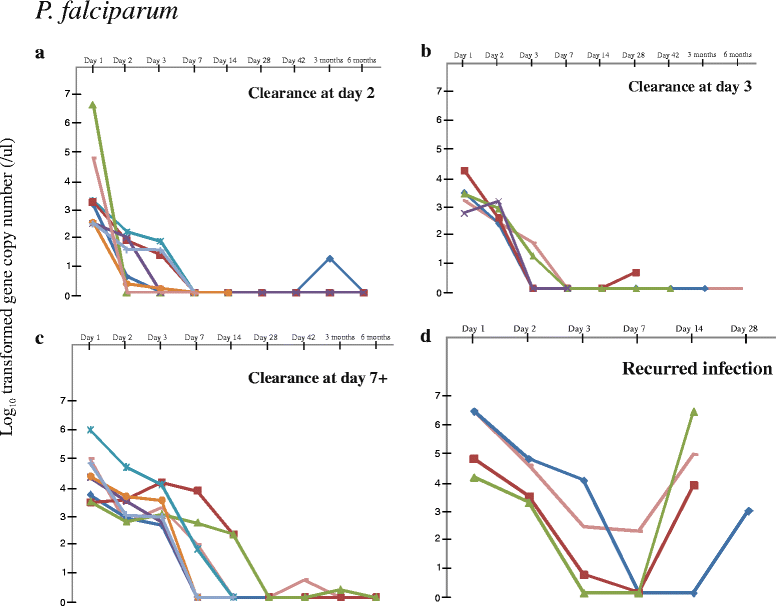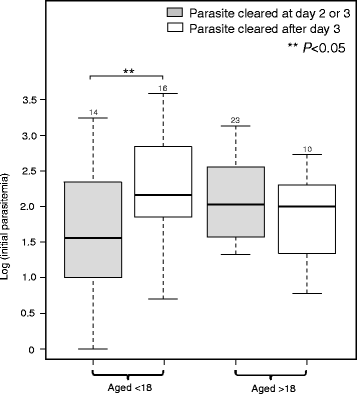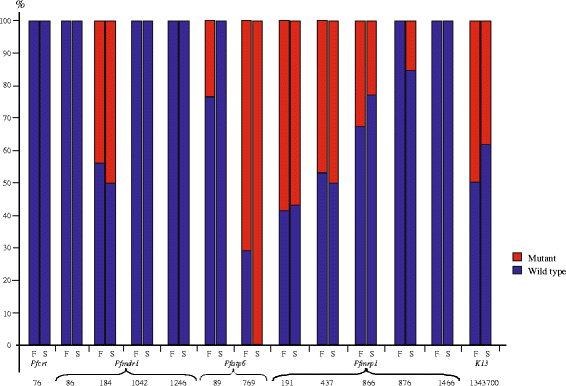Examining Plasmodium falciparum and P. vivax clearance subsequent to antimalarial drug treatment in the Myanmar-China border area based on quantitative real-time polymerase chain reaction
- PMID: 27084511
- PMCID: PMC4833920
- DOI: 10.1186/s12879-016-1482-6
Examining Plasmodium falciparum and P. vivax clearance subsequent to antimalarial drug treatment in the Myanmar-China border area based on quantitative real-time polymerase chain reaction
Abstract
Background: Recent emergence of artemisinin-resistant P. falciparum has posed a serious hindrance to the elimination of malaria in the Greater Mekong Subregion. Parasite clearance time, a measure of change in peripheral parasitaemia in a sequence of samples taken after treatment, can be used to reflect the susceptibility of parasites or the efficiency of antimalarials. The association of genetic polymorphisms and artemisinin resistance has been documented. This study aims to examine clearance time of P. falciparum and P. vivax parasitemia as well as putative gene mutations associated with residual or recurred parasitemia in Myanmar.
Methods: A total of 63 P. falciparum and 130 P. vivax samples collected from two internally-displaced populations and one surrounding village were examined for parasitemia changes. At least four samples were taken from each patient, at the first day of diagnosis up to 3 months following the initial treatment. The amount of parasite gene copy number was estimated using quantitative real-time PCR based on a species-specific region of the 18S rRNA gene. For samples that showed residual or recurred parasitemia after treatment, microsatellites were used to identify the 'post-treatment' parasite genotype and compared such with the 'pre-treatment' genotype. Mutations in genes pfcrt, pfmdr1, pfatp6, pfmrp1 and pfK13 that are potentially associated with ACT resistance were examined to identify if mutation is a factor for residual or persistent parasitemia.
Results: Over 30% of the P. falciprium infections showed delayed clearance of parasitemia after 2-3 days of treatment and 9.5% showed recurred parasitemia. Mutations in codon 876 of the pfmrp1 corroborated significance association with slow clearance time. However, no association was observed in the variation in pfmdr1 gene copy number as well as mutations of various codonsinpfatp6, pfcrt, and pfK13 with clearance time. For P. vivax, over 95% of the infections indicated cleared parasitemia at days 2-3 of treatment. Four samples were found to be re-infected with new parasite strains based on microsatellite genotypes after initial treatment.
Conclusion: The appearance of P.falciparum infected samples showing delayed clearance or recurred parasitemia after treatment raises concerns on current treatment and ACT drug resistance.
Keywords: Artemisinin-combined therapy; Malaria; Microsatellite; P. falciparum; P. vivax; Parasite clearance; Quantitative PCR; Resistance genes.
Figures





Similar articles
-
Prevalence of molecular markers of anti-malarial drug resistance in Plasmodium vivax and Plasmodium falciparum in two districts of Nepal.Malar J. 2011 Apr 1;10:75. doi: 10.1186/1475-2875-10-75. Malar J. 2011. PMID: 21457533 Free PMC article.
-
Plasmodium malariae and Plasmodium ovale infections in the China-Myanmar border area.Malar J. 2016 Nov 15;15(1):557. doi: 10.1186/s12936-016-1605-y. Malar J. 2016. PMID: 27846879 Free PMC article.
-
Therapeutic efficacy of artesunate in the treatment of uncomplicated Plasmodium falciparum malaria and anti-malarial, drug-resistance marker polymorphisms in populations near the China-Myanmar border.Malar J. 2012 Aug 16;11:278. doi: 10.1186/1475-2875-11-278. Malar J. 2012. PMID: 22898135 Free PMC article.
-
Molecular surveillance for drug-resistant Plasmodium falciparum in clinical and subclinical populations from three border regions of Burma/Myanmar: cross-sectional data and a systematic review of resistance studies.Malar J. 2012 Sep 19;11:333. doi: 10.1186/1475-2875-11-333. Malar J. 2012. PMID: 22992214 Free PMC article.
-
Geographic expansion of artemisinin resistance.J Travel Med. 2019 Jun 1;26(4):taz030. doi: 10.1093/jtm/taz030. J Travel Med. 2019. PMID: 30995310 Review.
Cited by
-
Molecular Detection of Residual Parasitemia after Pyronaridine-Artesunate or Artemether-Lumefantrine Treatment of Uncomplicated Plasmodium falciparum Malaria in Kenyan Children.Am J Trop Med Hyg. 2018 Oct;99(4):970-977. doi: 10.4269/ajtmh.18-0233. Am J Trop Med Hyg. 2018. PMID: 30105967 Free PMC article. Clinical Trial.
-
The health beliefs, dengue knowledge and control behaviors among internally displaced persons versus local residents in Kachin Special Region II, Myanmar.PLoS Negl Trop Dis. 2020 Jun 25;14(6):e0008321. doi: 10.1371/journal.pntd.0008321. eCollection 2020 Jun. PLoS Negl Trop Dis. 2020. PMID: 32584822 Free PMC article.
-
Plasmodium malariae Prevalence and csp Gene Diversity, Kenya, 2014 and 2015.Emerg Infect Dis. 2017 Apr;23(4):601-610. doi: 10.3201/eid2304.161245. Emerg Infect Dis. 2017. PMID: 28322694 Free PMC article.
-
Genome-Wide Scans for Ghanaian Plasmodium falciparum Genes Under Selection From Local and Chinese Host Populations.Front Cell Infect Microbiol. 2021 Feb 25;11:630797. doi: 10.3389/fcimb.2021.630797. eCollection 2021. Front Cell Infect Microbiol. 2021. PMID: 33718278 Free PMC article.
-
Evaluation of residual submicroscopic Plasmodium falciparum parasites 3 days after initiation of treatment with artemisinin-based combination therapy.Malar J. 2020 Apr 21;19(1):162. doi: 10.1186/s12936-020-03235-3. Malar J. 2020. PMID: 32316974 Free PMC article. Review.
References
-
- Beshir KB, Sutherland CJ, Sawa P, Drakeley CJ, Okell L, Mweresa CK, Omar SA, Shekalaghe SA, Kaur H, Ndaro A, Chilongola J, Schallig HDFH, Sauerwein RW, Hallett RL, Bousema T. Residual Plasmodium falciparum parasitemia in Kenyan children after artemisinin-combination therapy is associated with increased transmission to mosquitoes and parasite recurrence. J Infect Dis. 2008;2013:2017–2024. - PMC - PubMed
Publication types
MeSH terms
Substances
Grants and funding
LinkOut - more resources
Full Text Sources
Other Literature Sources

